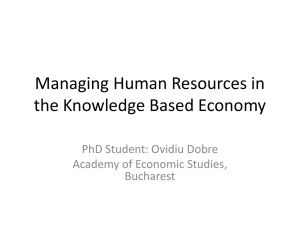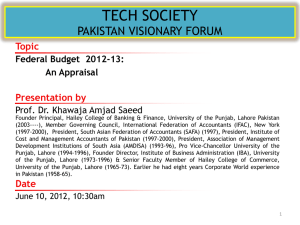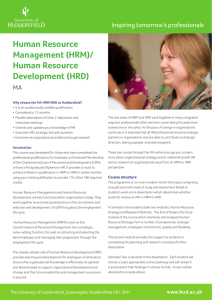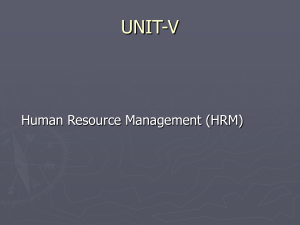Human-Resource-Management
advertisement
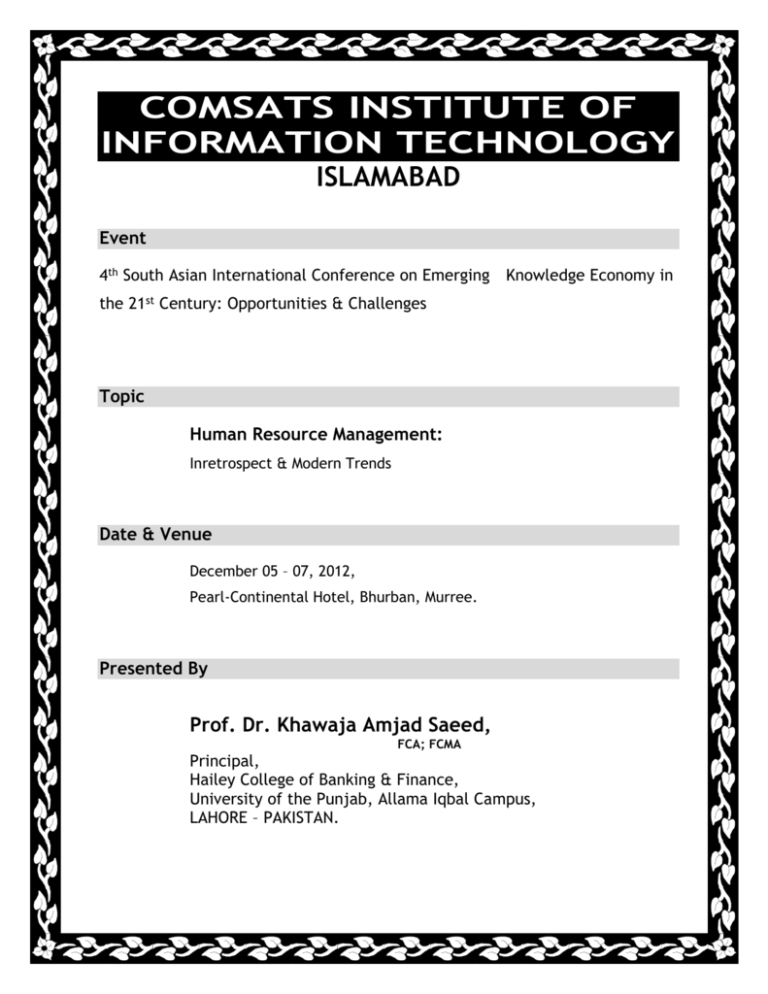
1 COMSATS INSTITUTE OF INFORMATION TECHNOLOGY ISLAMABAD Event 4th South Asian International Conference on Emerging Knowledge Economy in the 21st Century: Opportunities & Challenges Topic Human Resource Management: Inretrospect & Modern Trends Date & Venue December 05 – 07, 2012, Pearl-Continental Hotel, Bhurban, Murree. Presented By Prof. Dr. Khawaja Amjad Saeed, FCA; FCMA Principal, Hailey College of Banking & Finance, University of the Punjab, Allama Iqbal Campus, LAHORE – PAKISTAN. 2 HUMAN RESOURCE MANAGEMENT: Inretrospect and Modern Trends Prof. Dr. Khawaja Amjad Saeed* Email: kamjadsaeed@yahoo.com A: PRELUDE Management as a discipline is fairly young as compared to other disciplines. Philosophy is the oldest followed by politics, economics, statistics etc. We talk about management having started after Commercial and Industrial revolution of Europe during the 16th and 17th centuries when the concept of Joint Stock Company with limited liability was developed. For the first time, in the history of world those who provided the finance namely; shareholders, were separated from those who managed the affairs of the company namely; Directors. Therefore, several issues cropped up regarding management of an enterprise, its control and its accountability. Alongwith these aspects several schools of thoughts governing management arose. However, the school of thought which was developed and still continues to rule in the world is dominated by five aspects namely; Procurement, Personnel, Production, Finance and Marketing. Personnel Management has been given several names such as Human Resource Management / Human Resource Development. Its latest name is: Peoples Innovation resulting from Talent Development. All efforts are now focused to develop talent of human beings so that they can play their part productively to enable an enterprise to achieve its internal and external goals. With the passage of time, HRM / HRD have sprung into prominence. Major innovations are the outcome of the application of new thoughts through HRM / HRD. The rise of Apple through Steve Jobs, Windows through Bill Gates and various PC’s for Smart Phones are the outright result of human efforts. It may be interesting to note that Apple has top Rank No. 1 in global 3 brands (US$ 116 billion). Hitherto Coca-Cola has been dominating with Rank No. 1 as global brand (US$ 55). This piece will, in historical run down, review rise of HRM / HRD Inretrospect and also present some useful thoughts about its future outlook which augurs well for the prosperity and social stability of the people in the world. B: CONSTITUENTS We have been reviewing how to develop the constituents of this piece. Finally we thought that a good idea is to review the development of HRM / HRD throughout the annals of history. Significant among these are listed below: Part ---------I) Focus ---------------------------------------------------------------------------------------Human Resource Management / Human Resource Development (HRM / HRD) before the 16th century II) HRM / HRD during 17th to 20th century III) HR Trends in the 21st century IV) Suggested directions for future PART-1: HRM/HRD BEFORE THE 16TH OF CENTURY America had not been discovered. Africa was poverty stricken. Asia was being ruled by several colonial and feudal forces. Europe appeared to look as the only educated territory. However, before the dawn of the 16th century, the economies were dominated mostly by agriculture and small businesses. There was no legislation governing the above business. The idea of industrial relations was foreign to them. Mostly paternalistic approach by management was followed. Therefore, HRM / HRD did not occupy any importance. No laws were governing these and even internal rules and regulations to be developed voluntarily by the owners / managers were conceptualized, recorded and consequently also not practised. PART-II: HRM/HRD DURING THE 17TH CENTURY TO THE 20TH CENTURY The rise of Human Resource as a discipline was seen during and after Industrial and Commercial revolution in Europe during 1600’s & 1700’s. However, legislation aspects were lacking as democratic institutions were in their initial stage of being 4 in the offing. During 1800’s, industrialization caused human problems. Therefore, the management thought that the best way to handle human problems was through appointment of Welfare Secretaries to talk to the labour and find solutions to their problems. This system continued until the dawn of the 19th century when several industrial and commercial organizations started growing and there was no choice except to accept HR as a specialized subject. Management literature is full with various developments governing HR as part of scientific management which was developed by Fredick W. Taylor, who gave the right emphasis on improvement of productivity by utilizing work force in a much better manner by operationalizing Taylor Differentiated Wage Plan. Subsequently, several incentive schemes to synergize the workers with productivity and high results were developed and operationalized in various enterprises. Some of the prominent ones included Rowan Preium, Plan, Halsey Premium Plan, Halsey Wier System, Emerson Efficient System, Priestman Productive Bonus System, Towny gain Sharing Scheme, Merrick Differential Piece Rate System, Bedeaux Premium Point System, Gantt Task Bonus System, Barth Scheme, Scanlon Plan and, Rucker Plan* etc. (* Operational details in respect of these plans are available in book authored by Prof. Dr. Khawaja Amjad Saeed entitled: “Management: Concept and Cases” (2012 Edition), Lahore: Khawaja Publication, PP. 228 – 235. The 20th century also was governing legislation covering Minimum Wages, Trade 5 Unions, Dispute Settlement, Working Conditions, Safety, Industrial Relations, Environment, Labour Population etc. Legislation in respect of above and other related aspects were passed by the governments for regulating HR practices to benefit industrial relation system. In this respect, there are nearly 60 laws which governs labour in Pakistan and is needed to be freshly looked upon. However, at present there is a change in the 1973 Constitution of Pakistan, as through the 18th Amendment in the above Constitution, Labour is now considered as provincial subject and, therefore, a long way is needed to handle industrial relation issues. PART-III: HR TRENDS IN THE 21ST CENTURY The 21st century has witnessed great changes in the HR landscape. Lean Manufacturing, Internet Workers, Globalization of Business, Migration of Labour amongst the countries for work purposes, Down turn in the Socio-economic Economies in the world in general and developing countries in particular have given rise to various challenges. One wonders how will the future look like. One forecast is that, by 2030, 40% work forces will use smart phones and will work at home and deliver the goods rather than physically visiting the work premises. The rise of IT (Information Technology) is going to facilitate the above activities and HR text books needs to be rewritten. In this respect, E-HR has already brought tremendous changes in HR in the following areas as shown in Annex – “A”. Some of the topics covered in this respect are identified as under: 1) Acquiring HR. 2) Rewarding HR. 3) HRD (Training and Development). 4) Protecting HR. 5) Retaining HR. The traditional HR model focuse on the following stages: 6 Table – 1 HR Traditional Model _________________________________________________________________ Activity Movement of HR _________________________________________________________________________ 1) Move in Recruitment and Selection 2) Move around Training Render Service Undertaken operations 3) Move out Resigning Termination / Dismissal Die Etc., To face the challenges of the 21st century, HR needs new approach with expanded system. The following table captures some of the ideas to be practically implemented in toto by Management to optimize the benefits for the organization. Table – 2 Suggested Model for Future _________________________________________________________________ Particulars Focus _________________________________________________________________________ 1) Strategic Approach Development of Vision, Mission, Ethics, Values and Brands. 2) Approach Human Capital Management 3) Business Focus Intelligence, Decision and Transformations 4) Employees Autonomous with Empowerment and lesser gender inequality 5) Decision-Making “HIS command is only when HE intends a thing that - Divine System HE says to it. “Be” and “it is” (Surrah Yaseen: 36:82) Herbert Simon ( Nobel Prize Winner ) Focus: Operational directions Decision Criteria: Recognize Limited number Alternatives: Propose only a limited number Consequences: Be aware of a few Real Situation: Formulate simple method Satisfactory Solution: Select the alternative 7 _________________________________________________________________________ Normal HR Model constitutes seven points which are listed below: 1) Human Resource planning strategically be done. 2) Recruitment – Hiring the best. 3) Orientation & Training – Inducting with assured confidence. 4) Development – Continuous Professional Education (CPE). 5) Appraisal – To identify the best for retention and weeding out the unproductive ones. 6) Compensation – Payment for value addition. 7) Services – Motivating the employees through diversified Employees Service Programs. Suggested model for HRM / HRD for corporate sector is as under: 1) Strategic HRM. 2) Human Resources Planning. 3) Staff Acquisition and Retention. 4) Training and Developing. 5) Performance Management and Appraisal. 6) Compensation, Design and Administration. 7) Transformational Leadership. 8) International HRM. 9) Organization Communication. PART-IV: SUGGESTED DIRECTIONS FOR FUTURE All enterprises are suggested to absorb new HR International Trends and try to reflect them through application / practices in their set up. A suggested list in this respect is as under: 1) Use of Strategic HRM. 2) Continuous Professional Development (CPD). 3) Performance Development System (PDS). 4) Compensation Based on Output backed with Productivity. 5) Use of Internet Workers. 6) E – HR. 7) Developing Transformational Leadership. 8) Logistics for Intraentrepreneurship to be developed. 9) Encouragement of use of Information Technology (IT) in real life situation. 8 C: CONCLUSION It is high time that HR be given top priority in management function and talent Management to be given serious attention. New changing landscape of the World be comprehended and we must prepare to reorient our thinking about HR on modern lines to face the challenges of the 21st century by optimiziy benefits, generatiy wealth and enable/ensure business enterprises to play productive and profitable role in the World. *Professor Emeritus, Founder Principal, (2003------) Hailey College of Banking & Finance, University of the Punjab, Lahore Pakistan, Member Governing Council, International Federation of Accountants (IFAC) (1997-2000), President, South Asian Federation of Accountants (SAFA) (1997), President, Institute of Cost and Management Accountants of Pakistan (1997-2000), President, Association of Management Development Institutions of South Asia (AMDISA) (1993-96), Pro Vice-Chancellor University of the Punjab, Lahore (1994-1996), Founder Director, Institute of Business Administration (IBA), University of the Punjab, Lahore (1973-1996) and Senior Faculty Member, Hailey College of Commerce, University of the Punjab, Lahore (1965-73). Earlier he had eight years corporate life experience in Pakistan (1958-65). 9 Annex-“A” MANAGING HR SYSTEMS THROUGH IT Focus 1. Acquiring HR 2. Rewarding HR - Performance Evaluation - Compensation 3. HRD -Training & Development 4. Protecting HR -Health & Safety - Employee Relation 5. Retaining HR - Retention Strategies - Work family balance Traditional HR E-HR -Paper Resources -Filled in months -Geographical barriers -Cost through advertisements -Manual review -Face to face interview -Electronic Resource -Filled in weeks or days -Unlimited access to global applicants -Cost at selecting candidates -Scanning through electronic review -Distance Interviewing -Supervision evaluation -Face to face evaluation -Paper work -Salary and bonuses -Naïve employees -Internal equity -Changes made by HR- -360° evolution -Applied software (online and hard copy) -Output -Market salaries -Knowledgeable employees -External equity -Changes made by employees on line -Standardized class room training - Career path - Reactive decisions - Personal networking -Flexible on-line training -Employees manage themselves -Proactive planning -Electronic networking -Physical equipment -Physical fatigue -Reactive progress -Focus on employees management relation -Strong unions -Sexual harassment -Ergonomic consideration -Mental fatigue -Proactive progress -Focus on employee to employer relations -Not a major local problems -current and crucial HR activity -Not a major local problems -Online opinion on survey Development & monitoring of program -Weak unions - Use of technology for monitoring LIST OF ABBREVIATIONS CPD: Continuous Professional Development. HR: Human Resource. HRD: Human Resource Development. HRM: Human Resource Management. IT: Information Technology. PC: Personal Computer. PDS: Performance Development System. US: United States. 10 SELECTED BIBLIOGRAPHY 1) Armstrong, Michael (Latest Edition), A Handbook of Human Management Practice ( 1999 ), Dover: Kogan Page (US) Ltd 2) Beach, Dale S ( Latest Edition ), Personnel: The Management of People At Work, New York: MacMille Publishing Co., Inc. 3) Dessler, Garry ( 2008 ), Human Resource Management, New Delhi: Pearson. 4) Saeed, Khawaja Amjad (2012), Management: Text & Cases, Lahore: Khawaja Publications. 5) Saeed, Khawaja Amjad ( 2009 ), Personnel Management: HRM / HRD, Lahore: Khawaja Publications. 11
